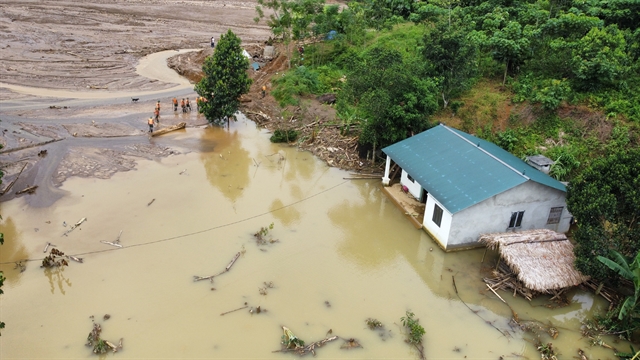 Society
Society

 |
| Large-scale landslide area in Nủ Village hinders search and rescue efforts. VNA/VNS Photo |
HÀ NỘI — Scientists estimated that about 1.6 million cubic metres of rock, mud and water poured into Nủ Village, Lào Cai Province, in just 300 seconds over a distance of 3.6km during the disastrous landslide on September 10, which left 58 people dead, 14 injured and nine others still missing.
This information was revealed at a scientific seminar on the causes of the Nủ Village disaster that took place in Hà Nội on Wednesday and also touched on preventive solutions.
Associate Professor Nguyễn Châu Lân, deputy head of the Department of Geotechnical Engineering at the Faculty of Construction, University of Transport, said erosion started on September 9, but the mud and rock flooded the area the next day.
"Through the application of a 3D model combining field data and satellite images, we've learned the flood took about 300 seconds, or five minutes, to flow from the top of the mountain down to the village," he said.
The landslide originated from Elephant Mountain, about 3.6km from the village. While moving, it was blocked, forcing the water and mud into a narrow area only about 100m wide, about 2km from the landslide's starting point. “This location accidentally created a natural dam, increasing the flooding risk,” Lân said.
At the time of the flood, rainfall in the area was recorded at 500mm on September 9 and 633mm on September 10, with the hourly rainfall reaching 57mm, causing the mud and rock-filled floodwaters to move extremely quickly, he said.
He warned that many geological cracks have appeared in mountainous provinces such as Hà Giang and Lào Cai, which need response measures to minimise potential disasters.
One of the solutions mentioned by the expert is to cover the cracks with tarpaulins, combined with a horizontal drainage and conduction system to prevent water from seeping deep into the ground, limiting the risk of landslides.
"This is such a simple measure that localities can quickly deploy, then use other technical solutions to handle the cracks," said Lân.
Professor Đỗ Minh Đức and the research team from the Department of Geotechnical Engineering and Infrastructure Development at the Faculty of Geology, University of Science (Vietnam National University), said: "The terrain, geological conditions and population distribution characteristics of Nủ Village are quite common in Việt Nam’s mountainous areas.”
Đức noted that some cracks will not immediately lead to landslides. Activities on sloping land can erase traces of cracks, but once cracks appear, the slope will not be able to heal itself, and the risk of landslides will always be latent.
He proposed early warning and action as short-term solutions.
“When the risk of landslides reaches level 1 under the Government's decree, local authorities need to restrict people and vehicles from traveling near high-risk areas. At level 2 and higher risks, vehicles must be strictly prohibited while residents in high-risk areas must be relocated to safe places and can only return when there is no longer a landslide risk warning,” he said.
Grassroots officers and volunteers can become active early detection forces, looking for the warning signs of landslides and flash floods, he said.
For medium-term solutions, Đức proposed protecting and developing upstream forests while issuing guidelines and strictly controlling the construction of transportation, irrigation and hydropower projects in landslide-prone sites, he said.
As for long-term solutions, he proposed creating a slope master plan and investing in infrastructure, as well as improving the quality of training in the earth sciences. — VNS




